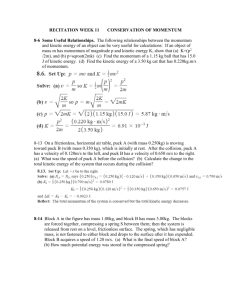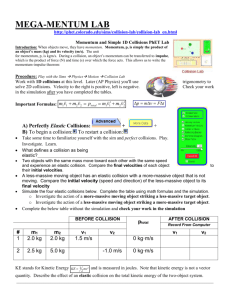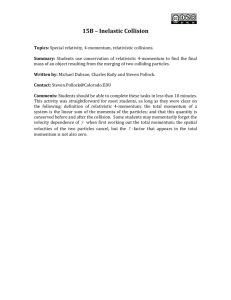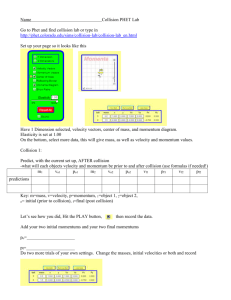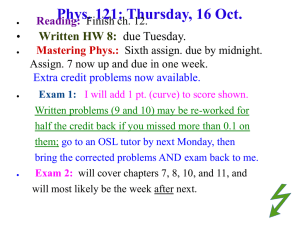Collision Lab Simulation - Methacton School District
advertisement
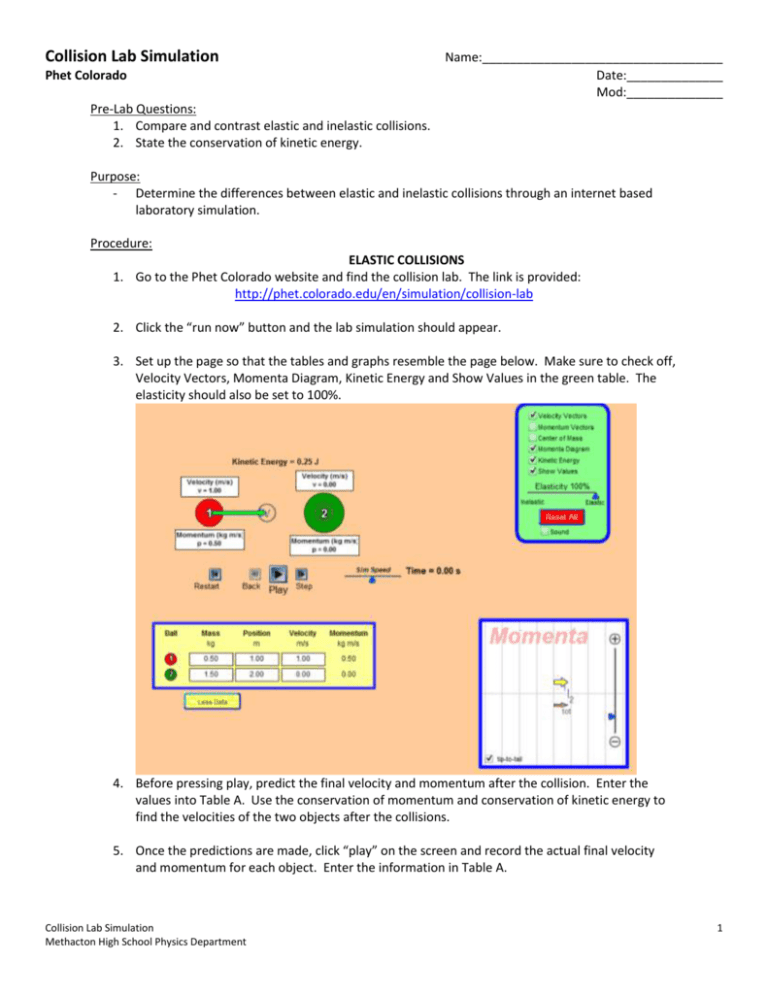
Collision Lab Simulation Phet Colorado Name:___________________________________ Date:______________ Mod:______________ Pre-Lab Questions: 1. Compare and contrast elastic and inelastic collisions. 2. State the conservation of kinetic energy. Purpose: - Determine the differences between elastic and inelastic collisions through an internet based laboratory simulation. Procedure: ELASTIC COLLISIONS 1. Go to the Phet Colorado website and find the collision lab. The link is provided: http://phet.colorado.edu/en/simulation/collision-lab 2. Click the “run now” button and the lab simulation should appear. 3. Set up the page so that the tables and graphs resemble the page below. Make sure to check off, Velocity Vectors, Momenta Diagram, Kinetic Energy and Show Values in the green table. The elasticity should also be set to 100%. 4. Before pressing play, predict the final velocity and momentum after the collision. Enter the values into Table A. Use the conservation of momentum and conservation of kinetic energy to find the velocities of the two objects after the collisions. 5. Once the predictions are made, click “play” on the screen and record the actual final velocity and momentum for each object. Enter the information in Table A. Collision Lab Simulation Methacton High School Physics Department 1 𝑚1 𝑣1𝑖 𝑝1𝑖 Table A – Experiment #1 𝑚2 𝑣2𝑖 𝑝2𝑖 𝑣1𝑓 𝑝1𝑓 𝑣2𝑓 𝑝2𝑓 Prediction Actual 6. Add the two initial momentums and the two final momentums from Table A. a. Σ𝑝𝑖 = _____________________ kgm/s b. Σ𝑝𝑓 = _____________________ kgm/s 7. Complete two more trials where you can pick the initial conditions for mass and velocity of the two objects. Complete the same steps as above and fill in the tables for Table B and Table C 𝑚1 𝑣1𝑖 𝑝1𝑖 Table B – Experiment #2 𝑚2 𝑣2𝑖 𝑝2𝑖 𝑣1𝑓 𝑝1𝑓 𝑣2𝑓 𝑝2𝑓 𝑚1 𝑣1𝑖 𝑝1𝑖 Table C – Experiment #3 𝑚2 𝑣2𝑖 𝑝2𝑖 𝑣1𝑓 𝑝1𝑓 𝑣2𝑓 𝑝2𝑓 Prediction Actual Prediction Actual 8. Once completing the 3 different experiments, solve for the kinetic energy lost for each trial using the actual values found from the simulation in the space provided. 𝐾𝐸𝑙𝑜𝑠𝑡 = Σ𝐾𝐸𝑖 − Σ𝐾𝐸𝑓 Collision Lab Simulation Methacton High School Physics Department 2 INELASTIC COLLISIONS 1. Click the “Reset All” button located in the green table. Once complete, change the elasticity to any number besides 100% and 0%. This will cause an inelastic collision between the two objects. 2. During the collision watch the momentum vector located in the graph as the collision takes place. Make sure to record the initial and final variables for the collisions. Experiment #4 BEFORE COLLISION Mass of object 1 initial v of 1 = initial p of 1 = Mass of object 2 initial v of 2 = initial p of 2 = Elasticity = Total initial p= AFTER COLLISION Mass of object 1 final v of 1 = final p of 1 = Mass of object 2 final v of 2 = final p of 2 = Did total momentum arrow change? Yes / no Total final p= Experiment #5 – Pick a new elasticity BEFORE COLLISION Mass of object 1 initial v of 1 = initial p of 1 = Mass of object 2 initial v of 2 = initial p of 2 = Elasticity = Collision Lab Simulation Methacton High School Physics Department Total initial p= 3 AFTER COLLISION Mass of object 1 final v of 1 = final p of 1 = Mass of object 2 final v of 2 = final p of 2 = Did total momentum arrow change? Yes / no Total final p= Experiment #6 – Set Elasticity to exactly 0% BEFORE COLLISION Mass of object 1 initial v of 1 = initial p of 1 = Mass of object 2 initial v of 2 = initial p of 2 = Elasticity = Total initial p= AFTER COLLISION Mass of object 1 final v of 1 = final p of 1 = Mass of object 2 final v of 2 = final p of 2 = Did total momentum arrow change? Yes / no Total final p= 3. Once completed, find the kinetic energy lost in experiments #4 through #6 in the space provided below: Post-Lab Questions: 1. In which cases was kinetic energy conserved? Explain why energy was lost in some collisions, but not in others. 2. Dis the total momentum ever change? Explain your reasoning. 3. When fully inelastic what did the two objects do differently? How did it affect the energy lost? Collision Lab Simulation Methacton High School Physics Department 4





